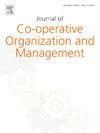Funding sources and their implications for the long-term financial sustainability of saving and credit cooperatives in Ethiopia
IF 2.5
Q3 MANAGEMENT
Journal of Co-operative Organization and Management
Pub Date : 2024-12-30
DOI:10.1016/j.jcom.2024.100258
引用次数: 0
Abstract
The subject of funding sources and financial sustainability in saving and credit cooperatives (SACCOs) has become more critical as microfinance institutions, previously reliant on donations, are now compelled to transition towards commercialized financing avenues. Hence, this study aims to examine the relationship between funding sources and the financial sustainability of SACCOs in Ethiopia. To address this objective, we analyzed a balanced panel dataset of 238 SACCOs spanning the years 2019–2021. Applying the correlated panel-corrected standard error (PCSE) and random-effects probit regression estimator, the findings indicate a positive and consistently significant association between member capital and deposit financing sources and the financial sustainability of SACCOs. At the same time, a high level of external borrowing balance in the SACCO's assets (debt-to-asset ratio) is found to insignificant impact on financial sustainability. However, evaluating the external borrowing proportion relative to member capital (debt-to-equity) demonstrates a positive contribution to financial sustainability. In addition, to account for potential differences in their operational environments and access to funding sources, a separate study of SACCOs in urban and rural SACCOs shows that capital structure variables have similar effects on their financial performance, except for the debt-to-asset ratio, which has a different effect on each. So, the optimal financing sources for SACCOs derive from member participation through member capital and deposit funding avenues.
埃塞俄比亚储蓄和信贷合作社的资金来源及其对其长期财政可持续性的影响
储蓄和信贷合作社的资金来源和财政可持续性问题已变得更加关键,因为以前依赖捐赠的小额供资机构现在被迫向商业化供资途径过渡。因此,本研究旨在研究埃塞俄比亚SACCOs的资金来源与财务可持续性之间的关系。为了实现这一目标,我们分析了2019-2021年间238家sacco的平衡面板数据集。应用相关面板校正标准误差(PCSE)和随机效应概率回归估计,研究结果表明,成员资本和存款融资来源与SACCOs的财务可持续性之间存在显著的正相关关系。同时,高水平的对外借款余额在SACCO的资产(债务与资产比率)被发现对财务可持续性的影响不显著。然而,评估外部借款相对于成员资本(债务股本比)的比例表明对财务可持续性有积极贡献。此外,考虑到其经营环境和资金来源的潜在差异,对城市和农村sacco的另一项研究表明,资本结构变量对其财务绩效的影响相似,但债务与资产比率对两者的影响不同。因此,SACCOs的最佳融资来源是通过会员资本和存款融资途径实现的会员参与。
本文章由计算机程序翻译,如有差异,请以英文原文为准。
求助全文
约1分钟内获得全文
求助全文
来源期刊
CiteScore
4.40
自引率
19.00%
发文量
27

 求助内容:
求助内容: 应助结果提醒方式:
应助结果提醒方式:


